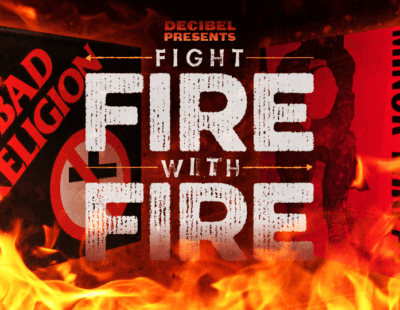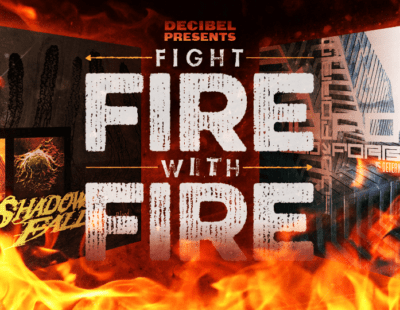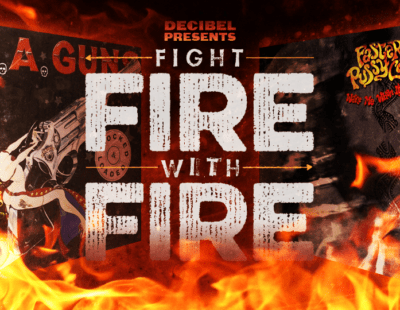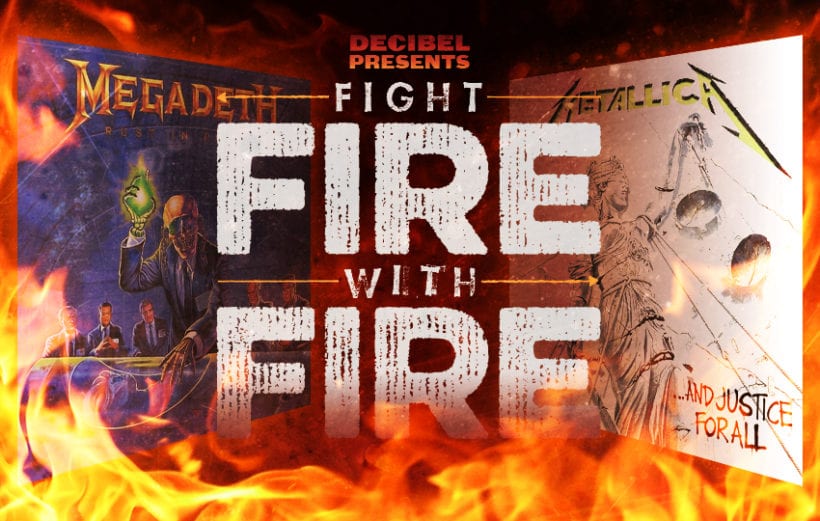
Fight Fire with Fire is an ongoing series on our site where we pit two classic genre albums against each other to definitively figure out which one is better. “But they’re both great!” you’ll say. Yes, these albums are the best of the best. But one is always better. Plus, we love these sort of exercises, and also love watching you battle each other to the death in the comments, so how could this possibly end poorly?
Today, we’re looking at two thrash classics, two Hall of Fame-inducted artefacts of absolute, undeniable genius. These two records kinda freak me out in how they are almost the absolute distillation of metallic intent, peak technicality, peak rage, peak focus. Rust in Peace. …And Justice for All. It doesn’t get much better that that.
But of the two, which one is better? Is it Megadeth’s best album or is it Metallica’s thrash climax?
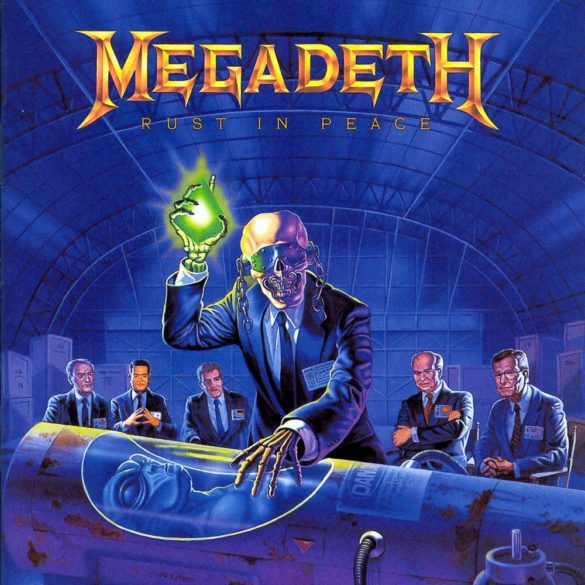
Megadeth – Rust in Peace
When ‘deth dropped their fourth album on September 24, 1990, the band was at the height of their powers, the Mustaine/Ellefson/Friedman/Menza lineup working together with a psychotic, clenched-teeth intensity on these nine songs as the group, led no doubt by Mustaine’s relentless urge for perfection, crafted songs that were just more, more, more. (Also, never forget that this was Marty Friedman and Nick Menza’s first album with the band.)
They were more, but they were never too much. Check out tracks like the classic “Hangar 18” or also classic “Holy Wars… The Punishment Due,” where the band manages to combine technical thrash wizardry with songwriting sorcery, creating songs that clash together like molten metal but also stick in your brain, always, forever.
Songs like the astounding “Take No Prisoners” and “Tornado of Souls” make my adrenaline levels go wonky every single time I listen to them; on the former, whatever was possessing Menza to play like that, I want. This album is a drum clinic but not in a buttoned-shirt sort of way, Menza instead hitting hard but with a technical skill that both drunken thrashheads emerging from the ’80s and, you know, Rush fans could appreciate. His work on this album is an absolutely essential piece of metal, one for the history books.
But everyone’s on fire, from Ellefson’s crazed bass work (see also “Take No Prisoners”) to the absolutely ludicrous guitar work, duelling solos all over the place, songs like “Hangar 18” being, I’m pretty sure, just a showcase for two guys going batshit on their guitars, but—and here’s the rub—doing it in a framework of a memorable song, and keeping the songs pretty economical and concise while they’re at it. The crazed guitar work—solo and rhythm—throughout this whole album is a pleasure to listen to.
“Poison Was the Cure” is like nothing we’ve ever heard before—’50s bubblegum pop sped up to an obscene degree during the verses, bonkers race-to-the-end apocothrash for the pre-chorus and chorus. It’s like nothing we’ve heard since, too. The reason for that is because Dave Mustaine’s mind circa this era is nothing no human has experienced before or since, the man’s pure determination to one-up his former bandmates in Metallica really netting some serious results here.
“Lucretia” has swing and swagger, and is just one “hey!” away from being totally hokey, but instead it’s totally awesome; “Tornado of Souls” has one of the best climaxes in thrash history (actually, two, maybe three, but who’s counting?).
I guess “Dawn Patrol” is kinda dumb, but it does actually work in the context of the album, giving us a bit of a break at song eight before the kinda-title-track ends it all off. And about that, “Rust in Peace… Polaris” is a crazed closer, the band again dropping a bit of swing to their cyborg thrash, the song bookending the album perfectly with “Holy Wars… The Punishment Due” (I can’t stress that enough: opening and closing the album with these songs was absolutely perfect), an incredible song made even more incredible by Mustaine managing to make the phrase “rotten egg air of death” sound totally convincing.
All the other boxes get checked off here: the production is perfect (listen to those toms), the runtime is a smart 40:44, which is absolutely, 100 percent in that all-important sweet spot of being long enough to be satisfying but short enough to leave us wanting to listen to it again.
Which I have done, again and again, countless times over the years, again and again, Rust in Peace being one of the great thrash albums that just gets better and better as the years go on. Contextually, it was massive when it came out, and it just seems to get more massive as the years go on.

Metallica – …And Justice for All
Two years before Megadeth dropped Rust in Peace on the world, Metallica gave us …And Justice for All. The thrashterpiece dropped on August 25, 1988 to a metal community still coming to terms with the majesty of Master of Puppets and the subsequent death of bassist Cliff Burton.
“Blackened” opens this up, and, as we all know, it’s an essential Metallica tune, all labyrinthine riffing and blinders-on thrashing and sure there’s no bass but it’s still completely shredding. James Hetfield is at peak anger here, on this whole record, spitting out lyrics that never again sounded so passionate.
The title track is truly epic; even though the “1! 1-2! 1-2-3! 1-2-3-4!” bit is the band pushing it with tech-for-tech’s-sake, the song as a whole is good enough to make us forgive that misstep.
“Eye of the Beholder” is awesome, Metallica actually laying down some hooks amongst all the technical thrashing, everything surprisingly mid-tempo when you really look back and analyze things closely, but the band not sacrificing heaviness at any point here, this song slicing and dicing in all the best ways, the guitar work classy thrash majesty.
Then there’s “One.” I found a number of years ago that this song had become so ubiquitous, so discussed, so over and done, that I wasn’t really processing it anymore when it played. I had to stop and do a force quit, a hard reset, and make myself hear it for the first time again, in the context of Metallica 1988, in the context of …And Justice for All. And holy shit: “One” is incredible. I mean, we all know this, but we all forgot this. “One” isn’t a ballad, “One” isn’t a thrasher, “One” is something else entirely, Metallica on this most exhausted of songs absolutely pulling things in a new direction. Here’s the thing: Megadeth weren’t capable of “One.” On …And Justice for All, Metallica were capable of doing just about anything, and “One” proves it, the band completely and utterly at the height of their powers.
The second half of this album was always quite different from the first half, things starting off with the more relatively straight-ahead thrash attack of “The Shortest Straw,” a decent enough song that is sort of forgotten when discussing this album, although the chorus is in every single one of our heads until the day we die, so that’s cool. I always thought “Harvester of Sorrow” was a highlight track here, the band plodding along with a very heavy thrash sludge and another excellent, memorable chorus.
“The Frayed Ends of Sanity” dealing in that weird Wizard of Oz thing is just… weird. But the rest of the song, much like this half of the record, is a delight of riffs, parts, and—yes—songs, all of which combine to create a wholly enjoyable listening experience, one that is actually aging very, very well, thank you very much.
“To Live Is to Die” is an exercise in pushing it, the almost-10-minute almost-instrumental a true test, but Metallica pull it off here, the band crafting a song that really takes the listener places, although it requires some investment, no doubt about it. Then “Dyers Eve” ends off the album with some simple, fast, “Battery”-ish thrashing, the song immediately becoming an anthem for lost teenagers worldwide emerging from the previous 60 minutes of technical thrash perhaps a bit confused, slightly angry for no concrete reason at the justice system, and inspired to play a goddamn instrument.
It’s hard to separate this album from so much Metallica lore—it’s the album between the greatest thrash album of all time and the extremely divisive self-titled album; it’s the one with no bass; it’s the one where they tried really, really hard—but you don’t really have to separate it from that to enjoy it. That context helps make Justice such an intriguing listen, much like listening to Rust is a more interesting experience when you know just how hard Mustaine was trying to basically annihilate the world at that point. There’s nothing simple about listening to Justice.
We all know that at 65:31, Metallica were really pushing their luck with this one; come the last half of “The Frayed Ends of Sanity” I often threaten to check out. There are no filler tracks here, but there are several tracks that, without a doubt, could have been a couple minutes shorter, which does prevent me from listening to this album sometimes.
Writing this column is always interesting: when I pitch the albums to my editor I usually am not really sure which one is going to win. They’re two records that occupy similar mental space in my mind and it’s not until I listen to them both side by side, repeatedly, and start ruminating on them that it becomes clear which one takes the lead. Curiously, it often ends up being the one I think it won’t be.
One of these albums is a technical thrash masterwork that is incredible but also, as noted, goes on too long, could use some editing, and can be a bit of an endurance test.
The other is our winner, and it’s a perfect summation of all that is great about adrenaline-racing, grinding-teeth, perfection-seeking thrash metal; today, we declare it the better record, and its name is Rust in Peace.


